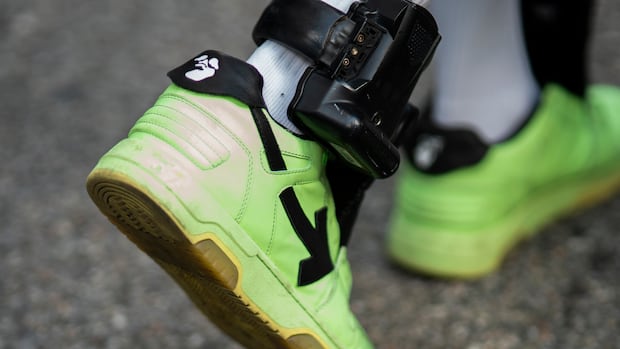More than half the people released with an ankle monitor since those devices were introduced in Manitoba in August 2024 were rearrested or broke the rules of their release while wearing one, recent numbers obtained by CBC News show.According to the justice minister’s office, 530 people were released through that program up to Oct. 16, 2025. Of those, 243 were rearrested for breaches of conditions or new crimes, 53 removed the device and fled, 16 damaged the strap and 12 let the battery die — making up just over 60 per cent of the total.Charges were stayed for 11 people, 19 were sentenced and one was acquitted. Eight people had their monitoring conditions removed, and one person died while wearing the device. As of Oct. 16, there were 166 people who still had ankle monitors.Those numbers were recently provided to CBC News by Justice Minister Matt Wiebe’s office, after the province previously refused to disclose them. The data was released after CBC obtained similar numbers during a recent bail hearing, where a Crown attorney used the stats to argue a man accused of domestic violence-related charges shouldn’t be released, even with an ankle monitor.Justice Minister Matt Wiebe holds an ankle monitor at a Nov. 29, 2024, news conference. (Prabhjot Singh Lotey/CBC)”The limits of the program are underlined by the statistics,” prosecutor Ben Wickstrom told a judge at the hearing, who ended up denying the accused bail. Manitoba boosts number of ankle monitors to track people on bail A Crown attorney in another recent bail hearing for a prolific alleged shoplifter went further, calling the program’s failure rate “staggering” — and noting his office has another case where a person was accused of stealing from a drugstore while wearing an ankle monitor.”I’ve often heard it said that, ‘Well, we know where an individual is [if they’re wearing an ankle monitor].’ Well no, we only know that if their battery’s charged [and] they haven’t removed the device,” Crown attorney Colin Soul said during the hearing. “This isn’t a far-fetched submission from the Crown — we know that this has occurred.”That accused’s bail was also denied.The province introduced ankle monitors last year, when Justice Minister Wiebe said they could be used to prevent repeat offending and ensure people follow their conditions while on release. The devices use 24/7 GPS tracking and real-time communication through voice, audio and vibration commands, and can play loud alerts if someone goes into an area they’re not allowed to be.Success or failure?Criminal justice professor Michael Weinrath said while there’s often interest in electronic monitoring because the ankle bracelet creates an idea of security, the latest numbers on Manitoba’s program suggest it’s “failed miserably.””I don’t think you need a fellow like myself with a PhD to tell people that these are not good numbers,” said Weinrath, who teaches at the University of Winnipeg. “They’re pretty stark.”In an interview last week, Justice Minister Wiebe said he thinks the province is seeing success in the program, in part because the devices’ GPS data lets authorities track people down quickly if they commit a breach or new offence.”Before now … the search would begin” in such cases, he said. “And that’s a huge strain on our law enforcement resources.”Manitoba’s NDP government reinstating ankle bracelet program that was cancelled in 2017 But Weinrath said including people still wearing the devices in the failure rate, instead of only looking at outcomes for people who have finished the program, is “a way to inflate the success numbers.”If the 166 still in the program are removed, its failure rate is actually 89 per cent.”I don’t know what program exists out there that has an 11 per cent success rate and that people are … really happy about that,” Weinrath said, adding that even with the Justice Department’s calculation, “you’re still over 50 per cent — those are not good numbers.”A November 2024 photo shows one of Manitoba’s ankle monitoring devices. The province rolled out the program in 2024 with a $2.9 million budget over two years, and later expanded it from 100 devices to up to 200, at an additional cost of $1.2 million for the year. (Prabhjot Singh Lotey/CBC)However, determining the program’s success depends on how you measure that, says defence lawyer Christopher Gamby.An ankle monitor detecting someone breaching could be considered a failure because they broke the rules, or a success because the device caught them, he said.Remand populations pushing Manitoba jails well over rated capacity, creating ‘volatile’ situation: union “If you believe that the objective of the program was to make it so that individuals … would never reoffend and would never breach their conditions, I suppose you could suggest that the program was not doing what it is intended to do,” said Gamby, who is also the communications director for the Criminal Defence Lawyer Association of Manitoba.”I don’t think that’s a realistic way to look at it. I think that if you have individuals who are being rearrested for failing to comply with the program, that’s probably a success story, ultimately.”Gamby said the program can also be helpful beyond tracking possible breaches — like in domestic violence cases, where accused people can be prevented from entering a certain radius that includes a complainant’s home.Over $4M budgeted for monitorsCriminologist Weinrath said it’s “concerning” that while Manitoba’s justice department is spending millions of dollars on ankle monitoring under claims it helps keep Manitobans safe, the province’s prosecutors are questioning the program’s effectiveness in court.”When you have that sort of conflict even within your own department, where people on the front lines are saying, ‘Well, let’s not use electronic monitoring because we know it’s not working’ … that seems to me a mark of a lack of success,” he said.However, Justice Minister Wiebe said he’s “happy to hear that our Crowns are being cautious with this program,” adding the province has given “clear direction” to prosecutors to consider public safety and confidence in the justice system in bail decisions.The province rolled out the program, overseen by Commissionaires Manitoba, in 2024 with a $2.9 million budget over two years, and later expanded it from 100 devices to up to 200, at an additional cost of $1.2 million for the year.Expanded ankle bracelet monitoring will help protect Manitoba intimate partner violence survivors: provinceA similar program was cut by the former Progressive Conservative government in 2017, following an NDP-initiated review of the program that former justice minister Heather Stefanson said found the bracelets were often inaccurate or ineffective. Before they were ousted by the NDP in 2023, the Manitoba PCs had also announced plans to reinstate electronic monitoring.’Where else could we be putting that money?’The reintroduction of ankle monitoring came amid calls for change to the bail system across the country, including in Manitoba, where Premier Wab Kinew earlier this month criticized a judge’s decision to grant bail to a driver accused in a fatal crash.During the recent bail hearing for the alleged shoplifter where ankle monitoring numbers were raised, defence lawyer Carl O’Brien urged the judge to let the law, not public reaction, guide her release decision.”You ought not to be concerned about public reaction of certain political figures who may feel they need to comment on a judge’s decision to grant bail — which has happened recently,” said O’Brien.Criminologist Weinrath said while he understands electronic monitoring appeals “because it’s technology and it’s sexy,” and the province has been under pressure to address calls for change in the justice system, he thinks the money would be better spent addressing issues that fuel crime.Manitoba youth with addictions face limited services, long waitlists, geographic barriers: reportManitoba advocate sounds alarm over youth addictions, calls on province for more support”Where else could we be putting that money? We could be putting that money in addictions treatment, we could be putting it in mental health treatment, trying to provide more support to our population that’s on bail,” he said.When it comes to the future of ankle monitoring in Manitoba, Wiebe said the province is going to continue to monitor it.”We’re going to make sure that it’s working. We know that there’s more communities that are asking for this program,” the justice minister said. “So we’re going to look at opportunities to continue to build out.”
Wednesday, 17 Dec 2025
Canada – The Illusion
Search
Have an existing account?
Sign In
© 2022 Foxiz News Network. Ruby Design Company. All Rights Reserved.
You May also Like
- More News:
- history
- Standing Bear Network
- John Gonzalez
- ᐊᔭᐦᑊ ayahp — It happened
- Creation
- Beneath the Water
- Olympic gold medal
- Jim Thorpe
- type O blood
- the bringer of life
- Raven
- Wás’agi
- NoiseCat
- 'Sugarcane'
- The rivers still sing
- ᑲᓂᐸᐏᐟ ᒪᐢᑿ
- ᐅᑳᐤ okâw — We remember
- ᐊᓂᓈᐯᐃᐧᐣ aninâpêwin — Truth
- This is what it means to be human.
- Nokoma











